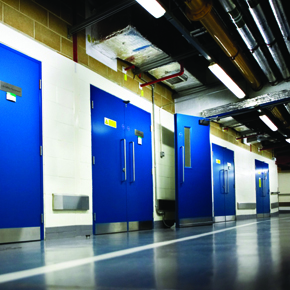
Improving fire safety with six door hardware steps
With an average of 174 buildings catching fire each day, it’s time for door hardware to be taken seriously and recognised for the important role it plays in fire safety.
Simon Osborne, sales leader UK and Ireland at specialist security manufacturer, Allegion, offers six steps to improve the effectiveness of fire doors through the installation and ongoing maintenance of fire door hardware…
Despite their importance, it is common to see fire doors that are wrongly specified and fitted, constantly propped open and therefore pointless, or left damaged through misuse.
Plus, fire door hardware and furniture, which includes closers, hinges and essential ironmongery, is often overlooked and it is usually these products that are the first to be downgraded during specification.
A quick look at the role that hardware plays in a fire door set makes it obvious why it is such a mistake to devalue it. After all, something as simple as an incorrect hinge can produce a life-threatening gap between the door and the frame that allows the flames to spread, while a malfunctioning handle can cut off a vital escape route.
Fortunately, making positive change is not only easy to implement but can be instant to apply. A simple hardware checklist that goes through the following six steps can add real value, both during the installation stage and throughout periods of maintenance.
Six steps for improving fire door safety
1. Door furniture A simple door handle can make all the difference when the outbreak of a fire makes a speedy exit a matter of life or death. Check that the handle operates smoothly and freely and returns to a horizontal position. All screws must be tightened. Also, if a fire door on an escape route needs to be locked for any reason, it shouldn’t require a key to be opened.
2. Hinges Don’t forget to inspect the hinges as they can dramatically impact how well the fire door opens and closes. Plus, they have a vital role to play in preventing the spread of flames by creating a reliable seal between the door and frame.
Check that there is a minimum of three hinges, all with securely fitted screws. Look out for signs of wear – is there any oil leakage or are there metal fragments present? The quality of the hinges also has an impact on the effectiveness of the fire door. Make sure the hinges used are marked with a CE stamp or that they are BS EN 1935 grade 13.
3. Locks and latches Again, an unsuitable latch can cause a gap which makes the seal between the door and the frame pointless. The latch should hold the door firmly in place without rattling and engage fully with the strike plate.
4. Door closers It is not uncommon to see a fire door propped open, particularly in high traffic areas such as offices or public corridors. An incorrectly specified closer (usually one that is too difficult to open or too powerful when closing) is often behind this problem.
It is always worth talking through the specification of the product and considering the potential impact of basing the purchasing decision purely on price. As well as the closer being securely fitted, it should be free from any damage or oil leakage. This should mean that when the door is opened to 5˚ or 75mm, it will close and engage with the latch. If unlatched, the closer should hold the door in line with the frame and intumescent seal.
5. Signage A very simple oversight is forgetting to apply the correct signage to the fire door. By ensuring prominent signage, it is hoped that propping open the door will be discouraged and regular maintenance will take place.
6. Exit devices Finally, all panic or emergency exit devices should be tested to ensure they are functioning correctly. Make sure to check the fixings of the operating device and tighten any bolts or strikes if necessary.
Ultimately, making subtle changes at all stages, from supply and specification, to operation and inspection, can encourage improvements in fire door standards. By supporting the customers that are installing and maintaining this hardware, it is hoped that the estimated three million fire doors sold each year, plus their vital hardware, are specified, installed and maintained correctly to prevent any loss of life from the outbreak of fire.
Find out more in the November issue of ABC+D Magazine
Latest news

19th April 2024
ASSA ABLOY: Access solutions can impact sustainability performance across the full life-cycle of a building
Embedding sustainability within any organisation requires a broad, strategic perspective. Scrutiny should include the physical infrastructure itself: According to the IEA, buildings consume around 30% of global energy*. ASSA ABLOY has more…
Posted in Access Control & Door Entry Systems, Architectural Ironmongery, Articles, Building Industry News, Building Products & Structures, Building Regulations & Accreditations, Building Services, Case Studies, Doors, Facility Management & Building Services, Information Technology, Research & Materials Testing, Retrofit & Renovation, Security and Fire Protection, Sustainability & Energy Efficiency, Video of the Week
19th April 2024
British weather doesn't dampen spirit for new HMG Garden Paint
Despite one of the wettest starts to the year on record, customers are starting to plan for brighter days with HydroPro Garden Paint from HMG Paints.
Posted in Articles, Building Industry News, Building Products & Structures, Garden, Innovations & New Products, Paints, Paints, Coatings & Finishes, Restoration & Refurbishment, Retrofit & Renovation, Site Preparation, Sustainability & Energy Efficiency, Waste Management & Recycling
18th April 2024
Abloy UK showcases new digital portfolio at The Security Event 2024
Abloy UK is set to unveil its latest line-up of access control systems at The Security Event 2024, welcoming guests to explore its cutting-edge electromechanical and digital solutions on stand 5/F50.
Posted in Access Control & Door Entry Systems, Architectural Ironmongery, Articles, Building Industry Events, Building Industry News, Building Products & Structures, Building Services, Doors, Exhibitions and Conferences, Facility Management & Building Services, Health & Safety, Information Technology, Retrofit & Renovation, Security and Fire Protection
18th April 2024
Strand is a Failsafe Choice for Emergency Exit and Panic Hardware
In times of emergency, you’re in safe hands with Strand Hardware. Although there are many considerations for building specification, few decisions can be as critical as selecting the right emergency exit/panic hardware.
Posted in Access Control & Door Entry Systems, Architectural Ironmongery, Articles, Building Industry News, Building Products & Structures, Building Services, Doors, Facility Management & Building Services, Health & Safety, Restoration & Refurbishment, Retrofit & Renovation, Security and Fire Protection
 Sign up:
Sign up: 